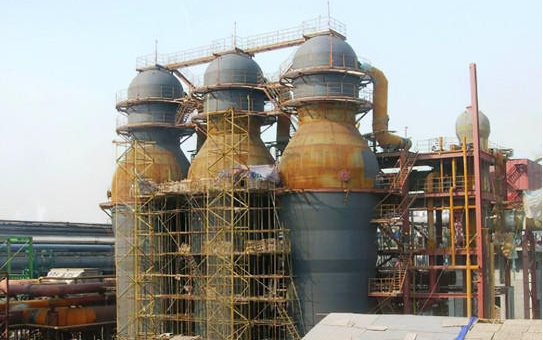- 23
- Oct
Blast furnace hot blast stove non-stop maintenance construction process and quality requirements
Blast furnace hot blast stove non-stop maintenance construction process and quality requirements
The hot blast stove maintenance masonry and spraying construction process are searched and compiled by the refractory brick manufacturer.

1. Features of non-stop masonry maintenance for hot blast stoves:
The construction is carried out in a state of non-stop production, and only one hot blast stove can be used at a time, and the others continue to work. When a hot blast stove is dismantled and repaired and put into production, the kiln will stop and the next hot blast stove will continue to be demolished, repaired, and put into production. Therefore, the hot blast stove non-stop masonry maintenance process is: removal, installation, masonry, oven, and production repeat until Repair of all hot blast stoves has been completed.
2. Preparation before masonry maintenance of hot blast stove:
(1) The shell of the hot blast stove is installed in place, the welding is completed, and the welding seam inspection is qualified, and the acceptance is completed;
(2) The grate column and grate have been installed and checked to confirm that they meet the design and construction requirements;
(3) The welding of the flue outlet, hot air outlet, gas outlet, air outlet, temperature measurement, pressure measurement hole and short manhole pipe is completed, and the quality is confirmed to be qualified and the acceptance is completed;
(4) The drawing line markings such as the centerline, elevation, measurement signs and control points of the hot blast stove body are accurate and clear;
(5) The installation and welding of the anchors are completed, and the quality inspection is qualified and the acceptance is completed;
(6) The quantity, quality and material of refractory materials are qualified and stored properly and orderly after entering the site;
(7) Use various engineering equipment, appliances, etc. to pass the trial operation and enter the site.
3. Hot blast stove masonry construction process:
(1) Masonry construction process arrangement:
No. 1 hot blast stove masonry, hot blast main pipe masonry → new and old hot blast main pipe connection and masonry, new and old flue branch pipe connection and masonry → No. 2 hot blast stove masonry, new and old hot blast main pipe connection and masonry, new and old flue Branch pipe connection and masonry → No. 3 hot blast stove masonry, new and old hot blast main pipe connection and masonry, new and old flue branch pipe connection and masonry.
(2) Paint spray construction arrangement:
1) Spraying construction of the furnace shell below the “S” bend root: The grate should be used as the dividing line for spraying construction, the lower part of the grate should be sprayed with scaffolding, and the upper part of the grate should be sprayed with a rigid hanging plate. The spraying sequence here is from top to bottom.
2) Spraying on the upper part of “S” bend: The spraying sequence should be carried out in stages from bottom to top, and the hemispherical part shall be left for the last spraying.
3) Quality requirements for spray coating layer:
The spraying distance should be 1~1.2m, and the thickness of each spraying should be controlled at about 40~50mm.
If the thickness of the spray coating exceeds 50mm, it should be sprayed twice, and the interval between the two should not exceed the initial setting time of the spray coating.
The surface of the sprayed layer should be smooth and free of cracks, looseness, peeling, etc., and the unevenness of the coating should not be greater than 5mm.
The spray construction joint should be set at the segmented position or the joint of the style net. Various interruption problems should occur during the spraying process. The interruption should be roughened. Before spraying again, the joint should be moistened with water before continuing spraying.
After the spray coating layer is applied to a certain area, it should be leveled and adjusted accurately with radius gauges.
After the leveling treatment is completed, check the quality, thickness and radius of the spray coating layer and confirm that it meets the design requirements.
